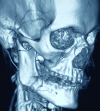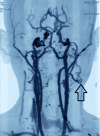Super-selective Embolisation and Surgical Excision of the Facial Arteriovenous Malformation
- PMID: 38686263
- PMCID: PMC11056801
- DOI: 10.7759/cureus.57240
Super-selective Embolisation and Surgical Excision of the Facial Arteriovenous Malformation
Abstract
Vascular anomalies broadly include vascular tumours and malformations. Arteriovenous malformations (AVM), though rare in the oral and maxillofacial regions, can present with swelling, facial asymmetry, ulceration, and bleeding tendencies, which can be life-threatening. Thus, to minimise the associated life-threatening consequences, prompt and appropriate diagnosis of the lesion is necessitated. The management of the AVM is a therapeutic challenge for maxillofacial surgeons; however, technological advances in interventional radiology have gained a foothold. Super-selective embolisation of the feeder vessels with subsequent resection of the lesion is the most widely accepted approach for management. The present report describes a unique case of a facial AVM managed through a trans-oral approach without any post-operative sequelae.
Keywords: arterivenous malformation; face; intraoral approach; resection; superselective embolisation.
Copyright © 2024, Chaulagain et al.
Conflict of interest statement
The authors have declared that no competing interests exist.
Figures







Similar articles
-
Treatment of facial vascular malformations with embolisation and surgical resection.Eur Rev Med Pharmacol Sci. 2012 Mar;16(3):407-13. Eur Rev Med Pharmacol Sci. 2012. PMID: 22530359
-
Primary free fibula reconstruction in life-threatening haemorrhage from high flow arteriovenous malformation of mandible.Indian J Plast Surg. 2018 May-Aug;51(2):222-230. doi: 10.4103/ijps.IJPS_13_18. Indian J Plast Surg. 2018. PMID: 30505095 Free PMC article.
-
Massive glosso-cervical arteriovenous malformation: The rationale for a challenging surgical resection.J Clin Exp Dent. 2014 Oct 1;6(4):e456-9. doi: 10.4317/jced.51608. eCollection 2014 Oct. J Clin Exp Dent. 2014. PMID: 25593675 Free PMC article.
-
Endovascular treatment of pulmonary and cerebral arteriovenous malformations in patients affected by hereditary haemorrhagic teleangiectasia.Curr Pharm Des. 2006;12(10):1243-8. doi: 10.2174/138161206776361237. Curr Pharm Des. 2006. PMID: 16611106 Review.
-
Endodontic implications of a patient with arteriovenous malformation: a case report and literature review.Int Endod J. 2021 Jun;54(6):975-987. doi: 10.1111/iej.13473. Epub 2021 Jan 27. Int Endod J. 2021. PMID: 33410128 Review.
References
-
- Hemangiomas and vascular malformations in infants and children: a classification based on endothelial characteristics. Mulliken JB, Glowacki J. Plast Reconstr Surg. 1982;69:412–422. - PubMed
-
- Vascular malformations: classification, diagnosis and treatment. Carqueja IM, Sousa J, Mansilha A. Int Angiol. 2018;37:127–142. - PubMed
-
- Current management of hemangiomas and vascular malformations. Marler JJ, Mulliken JB. Clin Plast Surg. 2005;32:99-116, ix. - PubMed
-
- Hemangiomas, vascular malformations, and lymphovenous malformations: classification and methods of treatment. Jackson IT, Carreño R, Potparic Z, Hussain K. Plast Reconstr Surg. 1993;91:1216–1230. - PubMed
Publication types
LinkOut - more resources
Full Text Sources
